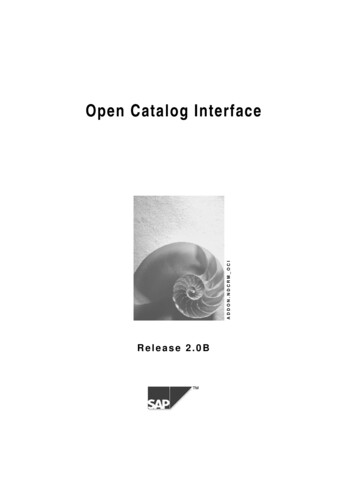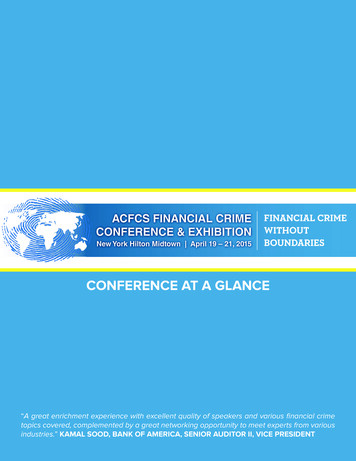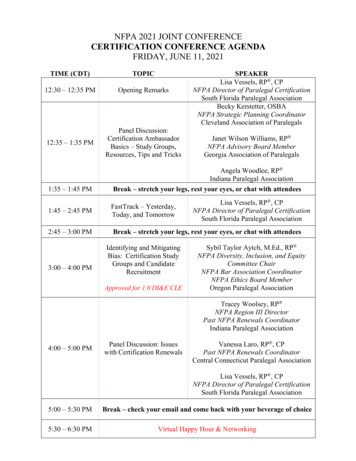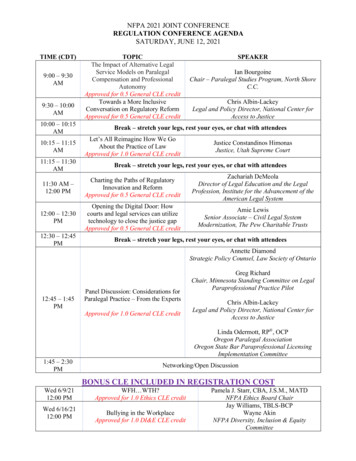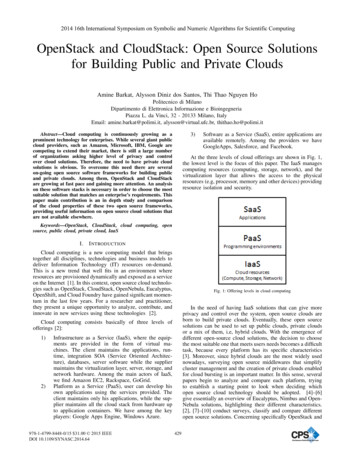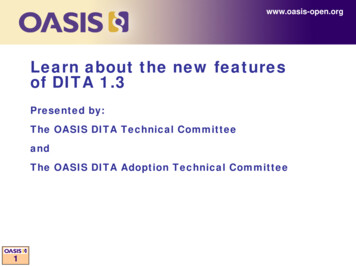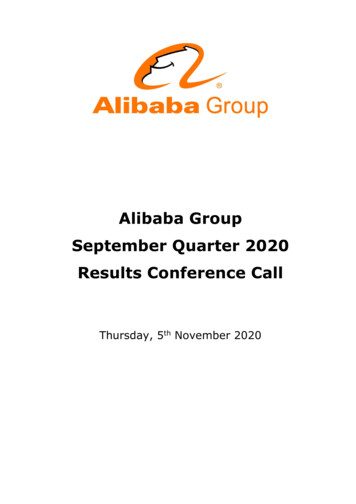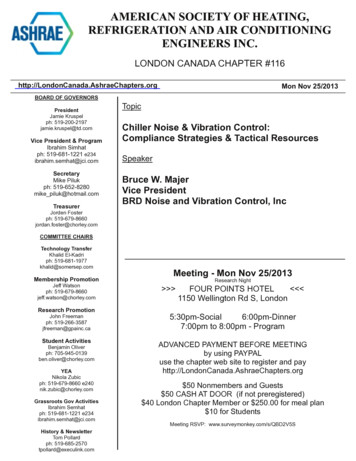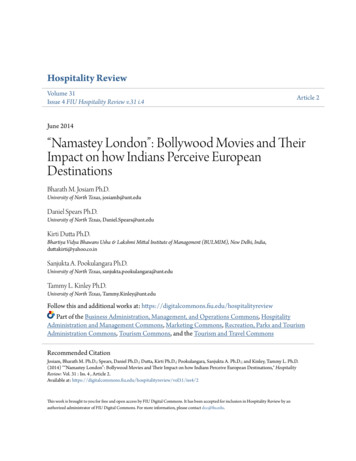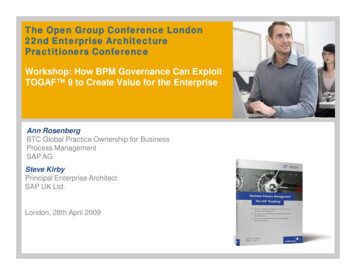
Transcription
The Open Group Conference London22nd Enterprise ArchitecturePractitioners ConferenceWorkshop: How BPM Governance Can ExploitTOGAF 9 to Create Value for the EnterpriseAnn RosenbergBTC Global Practice Ownership for BusinessProcess ManagementSAP AGSteve KirbyPrincipal Enterprise ArchitectSAP UK Ltd.London, 28th April 2009
DisclaimerThis presentation outlines our general product direction and should not berelied on in making a purchase decision. This presentation is not subject toyour license agreement or any other agreement with SAP. SAP has noobligation to pursue any course of business outlined in this presentation or todevelop or release any functionality mentioned in this presentation. Thispresentation and SAP's strategy and possible future developments aresubject to change and may be changed by SAP at any time for any reasonwithout notice. This document is provided without a warranty of any kind,either express or implied, including but not limited to, the implied warrantiesof merchantability, fitness for a particular purpose, or non-infringement. SAPassumes no responsibility for errors or omissions in this document, except ifsuch damages were caused by SAP intentionally or grossly negligent.
AgendaEvolution of Process Management and Enterprise ArchitectureExplore the SAP BPM Governance FrameworkConnections between BPM Governance and TOGAF 9/SAP EAF SAP 2009 / Ann Rosenberg/ BPM Page 3
AgendaEvolution of Process Management and Enterprise ArchitectureExplore the SAP BPM Governance FrameworkConnections between BPM Governance and TOGAF 9/ SAP EAF SAP 2009 / Ann Rosenberg/ BPM Page 4
Business Process Management Is aManagement DisciplineBusiness Process Management (BPM) is a management discipline that requiresorganizations to shift to process-centric thinking, and to reduce their reliance ontraditional territorial and functional structures.BPM requires and enables organizations to manage the complete revision cycles oftheir processes, from process design to monitoring and optimization, and to changethem more frequently to adjust to changing circumstances.The development of BPM technologies is enabling business managers to abstractprocess flows and rules from the underlying applications and infrastructure, and tochange them directly.BPM is neither a technology nor an updated version of BPR. It is an IT-enabledmanagement discipline. It represents a fundamental change in how business manageand run their processesSource: Gartner Business Process Management Summit 2007 SAP 2009 / Ann Rosenberg/ BPM Page 5
What drives BPMEconomic downturn necessitates improvement in business processes.Volatile business environments require frequent business process change.Regulatory and compliance requirements increase need for processtransparency and consistency.Globalization and proliferation of networked business relationships increaseprocess complexity, driving the need for more process visibility.Business stakeholders are more technology-savvy.Technology can now support model-driven manipulation and compositionof processes throughout the process life cycle.Source: Gartner Q4 2008 – Market Trends SAP 2009 / Ann Rosenberg/ BPM Page 6
A New Strategic Context for BPMSOASource: Business Process Management - The SAP Roadmap SAP 2009 / Ann Rosenberg/ BPM Page 7EA
What drives BPM - BPM Use CasesProcess-Based ApplicationRedesign for a Process-Based SOABusiness buyer (supported by IT)IT and business buyerRapid time to solution for new applicationImprove visibility and change managementExtension to existing applicationsGoal is broader, and better coordination ofmission-critical processBudget Trend: typically single projectGoal is application rationalization and modernizationBudget Trend: Level funding, increasing investment ifcombined with CPI or shared servicesContinuous Process ImprovementBusiness and IT as buyerBPM is a program, consisting of multiple projectsGoal is business agility for key processesBudget Trend: Level or increasing investmentSource: Gartner Q4 2008 – Market Trends SAP 2009 / Ann Rosenberg/ BPM Page 8Business TransformationSenior business executive as buyerRethink entire business processGoal is make a "game-changing" playIterative versus “big bang” approach to achievingtransformationBudget Trend: Level or increasing budget
http://www.gartner.com/it/page.jsp?id 855612 SAP 2009 / Ann Rosenberg/ BPM Page 9
BPM FactsBetween September and November 2008, Gartner BPM analysts interviewed morethan 40 BPM customer references for the forthcoming 2009 BPMS Magic Quadrantreport.None of these organizations reported budget cuts to BPM projects this year or anticipatedthem in 2009Most indicated that investments in BPM would outpace other investments over the next 12monthsQuotes from BPM customers:“I don’t have to budget extra funding for BPM. BPM is a faster way to do what’s already inmy budget and at 1/6 the cost.” – CIO Global Insurance Company“I’ve reduced my IT budget by 30% and tripled output to support the business, by usingBPM.” – CIO Auto Manufacturer.“BPM is a very ‘lean’ approach – no pun intended. BPM projects are escaping budget cutsbecause they offer rapid ROI that is visible and believable to the business.” – PLMManager, Discrete Manufacturing.Source: Gartner Q4 2008 – Market Trends SAP 2009 / Ann Rosenberg/ BPM Page 10
The Evolution of Process ManagementEvolution (Quality)Central IdeasBusiness ProcessProcess LifecycleCapability ering LeanManufacturingTotal QualityManagementSix-sigmaEvolution (Time) SAP 2009 / Ann Rosenberg/ BPM Page 11
From 2nd Generation to 3rd Generation# Projects2ndGeneration3rdGenerationTime SAP 2009 / Ann Rosenberg/ BPM Page 12
Architectural Maturity Stages, by RossCompanies move from standardization to businessmodularityHistoryBusinessSilosIT capabilityBusinessobjectivesWho rityDynamicVenturingLocal ITapplicationsShared technicalplatformsCompanywidestandardized processesor ssmerging withpartners’systemsROI of localbusinessinitiativesReduced IT costCost and quality ofbusiness operationsSpeed tomarket;strategic agilityROI of newbusinessventuresLocal businessleadersIT and business unitleadersSenior managementand process leadersIT, business,and industryleadersIT, business,and industryleaders andpartnersLocal/functionaloptimizationIT efficiencyBusiness/operationalefficiencyStrategic agilityOrganicreconfigurationSource: Ross et. al, 200613 SAP 2009 / Ann Rosenberg/ BPM Page 13
Business Process Modeling in ARISBusiness Process Management covers both automatedand manual perspectiveManual ActivitiesTypically 80%End to End process spansmanual and automatedactivitiesAutomated ActivitiesTypically 20%Typically 20%Differencing ActivitiesTypically 80%Standard ActivitiesProcesses that should be as costeffective as possible SAP 2009 / Ann Rosenberg/ BPM Page 14Composing in GalaxyProcesses that deliver competitiveadvantage and evolve regularly(SOA –Candidates)Of the 20% of AutomatedActivities
Case study “Arla Foods “IT history” and the direction outlined inthe strategic IT plan for 2007-2012.”(Ross, Standardized Technology and Optimized Core) SAP 2009 / Ann Rosenberg/ BPM Page 15(Ross, Business Modularity)
Case study “Arla Foods “IT history” and the direction outlinedin the strategic IT plan for 2007-2012.”(Ross, Business eSOA SAP 2009 / Ann Rosenberg/ BPM Page 16
The process maturity journey which is needed toexecute Business Modularity(Ross, Business Modularity)Level 5Level 4(Ross, Standardized TechnologyLeveland Optimized Core)Level 2Level 1Based on CMMI SAP 2009 / Ann Rosenberg/ BPM Page 17Most ProcessesOrganizedTransformation NeedProcesses areimproved at thework group ordepartment levelProcesses areorganized andredesigned at theenterprise levelProcesses aremeasured andmanagedsystematicallyIT cost reduction andcontrol Reduce time-to-market DocumentedprocessesBusinessresponsiveness Change businessprocess quickly andeffectivelyTransformation fromreactive to real-time Increase TransparencyA culture of heroesNew FunctionalityProcesses aremanagedSome organizedprocessesNo organizedprocesses 3Processes arecontinuously improved Process Teamscontinuouslyimprove processes Business optimization Increase decisionquality Optimization acrossboarders of Bus.& IT
A New Strategic Context for BPMSOASource: Business Process Management - The SAP Roadmap SAP 2009 / Ann Rosenberg/ BPM Page 18EA
SAP‘s Roadmap forBusiness Process Management (BPM)Methodology and RANSITIONLINK TO STRATEGYDEFINE BASICSCREATE BASISDEFINE BUILDING BLOCKSDEVELOP ANALYTICSPERFORM ANALYSISADD PROCESS-BASEDREWARDS EXPAND REPORTINGCHOOSE PATHCREATE METHODSDEFINE PORTFOLIOALLOCATE BUDGETMONITOR FIT-GAPHARMONIZE TERMSOPTIMIZE PROCESSESPERFORM AUDITS COMMUNICATE & TRAINMANAGE CHANGEBUILD PROCESS-CENTRIC ITBPM TechnologyBPX Certification and BPX Communityvoted #3 in terms ofpopularity onwww.sappress.com. SAP 2009 / Ann Rosenberg/ BPM Page 19
AgendaEvolution of Process Management and Enterprise ArchitectureExplore the SAP BPM Governance FrameworkConnections between BPM Governance and EAF/TOGAF 9 SAP 2009 / Ann Rosenberg/ BPM Page 20
SAP‘s Roadmap forBusiness Process Management (BPM)Methodology and RANSITIONLINK TO STRATEGYDEFINE BASICSCREATE BASISDEFINE BUILDING BLOCKSDEVELOP ANALYTICSPERFORM ANALYSISADD PROCESS-BASEDREWARDS EXPAND REPORTINGCHOOSE PATHCREATE METHODSDEFINE PORTFOLIOALLOCATE BUDGETMONITOR FIT-GAPHARMONIZE TERMSOPTIMIZE PROCESSESPERFORM AUDITS COMMUNICATE & TRAINMANAGE CHANGEBUILD PROCESS-CENTRIC ITBPM TechnologyBPX Certification and BPX Communityvoted #3 in terms ofpopularity onwww.sappress.com. SAP 2009 / Ann Rosenberg/ BPM Page 21
In order to realize a BPM Governance, SAP offers astructured 4 step approachSAP BPM Governance1234STRATEGYSET-UPTRANSITIONLINK TO STRATEGYDEFINE BASICSCREATE BASISDEFINE BUILDING BLOCKSDEVELOP ANALYTICSPERFORM ANALYSISCONTINUOUSIMPROVEMENTADD PROCESS-BASEDREWARDS EXPAND REPORTING CHOOSE PATHCREATE METHODSDEFINE PORTFOLIOALLOCATE BUDGET MONITOR FIT-GAPHARMONIZE TERMSOPTIMIZE PROCESSESCOMMUNICATE & TRAINMANAGE CHANGEBUILD PROCESS-CENTRIC IT SAP 2009 / Ann Rosenberg/ BPM Page 22PERFORM AUDITS
The Strategy phase follows a structured 4 stepapproachPhaseActivities1. Link to StrategyUnderstanding and definition of how business process managementsupports the corporate strategy1STRATEGYLINK TO STRATEGY2. Define Building BlocksDetermining the factors that need to be considered, analyzed, andadjusted to make BPM a successDEFINE BUILDINGBLOCKS3. Choose PathDefinition of the best way to approach Step 3 of the Roadmap, theTransition PathCHOOSE PATH4. Monitor Fit-GapReporting on and reviewing the defined building blocks during theoverall BPM transformationMONITOR FIT-GAP SAP 2009 / Ann Rosenberg/ BPM Page 23
Fators to be investigatedFactors to be investigatedCompany vision and strategy (ex. Product Leadership,Operational Excellence etc.)Company ChallengesExisting Management set-up discipline (top down,bottom up)Success in respect to M&AEnterprise Architecture MaturityProcess Management MaturityEnterprise Architecture linking to the Business StrategyFunctional or Process-Centric IT Department SAP 2008 / Nicole Berg & Christian Kern / Page24 SAP 2009 / Ann Rosenberg/ BPM Page 24Result
BPM has to be understood as an enabler ofthe company’s strategyBy developing a BPM strategy based on thecorporate strategy, a clear linkand transparency can be created between theprocesses and the strategy.Demonstrating this strategic benefit of BPM willmake it much easier to convince the relevantstakeholders to turn the enterprise into aprocess oriented organization.Topics to be adressed: Goal (what) Rationale for action (why) Statement of direction (how) Approach (Deliverables/Commitments) SAP 2009 / Ann Rosenberg/ BPM Page 25
The Company existing organization playsan elementary role for the designProcess related organizational structures(Schmelzer/ Sesselmann, 2006) SAP 2009 / Ann Rosenberg/ BPM Page 26
Several factors have to be considered whendeveloping a BPM strategyUnderstand the focus and goal of the corporate strategyFor growth to increase, for example, the company may need to develop innovative products orservices of higher quality. Or the company is facing strong competition and may need toimprove its time-to-market. With an acquisitions strategy, the focus is on synergies, scalability,and the reduction of costs.Include all relevant partiesA BPM strategy can only be completed by obtaining relevant information from senior managers,subject matter experts, and process performers.Obtain feedback and communicate openlyNot only should information be acquired from the relevant parties but also feedback after eachstep is completed so that appropriate adjustments can be made.Develop measurable objectivesPart of the BPM strategy should include metrics to provide transparency on the approach andboost credibility with senior management, the business units, and IT. Finally, a timeline andmilestones should be developed to assess the progress made in implementing BPM. SAP 2009 / Ann Rosenberg/ BPM Page 27
Having understood the strategy, severalbuilding blocks need to be analyzedOnce the link between business process management and the corporate strategy is understood, the companyneeds to analyze its current process management maturity and determine what factors, or building blocks, need tobe introduced or improved in the BPM nsOrganizationGuidelines &StandardsIT OperationsBPMEnablementSkill ProfilesProcessoriented Strat.PlanningProcessMaturity PlanOrganizationalStructureBPM MethodsSystemArchitectureManagementBPM ToolLandscapeTrainingProject PortfolioManagementDecisionMaking BodiesProcessTerminologyIT entRoles andTasksToolConventionsIT SupportOrganizationalInteractionProcess tionProcessPerformanceMeasurementChange Mgt.CorporateProcessReportingAuditing SAP 2009 / Ann Rosenberg/ BPM Page 28Budget andCost Allocation
Definition of building blocksPeoplePersonnelDevelopmentSkill ProfilesTrainingSkill Profiles:Defining and developing new skills to meet the requirements of process-centric operations.Training:Creating and executing trainings so that the employees obtain the necessary skills, based onthe Skills Profiles, required in a process-oriented company.Process-based Rewards:Defining personal goals on the basis of process related goals and process ation:Providing information about the BPM efforts, enabling collaboration and active participation tosupport the transformation.CommunicationChange Management:Ensuring that all levels of the company and all employees of the company are prepared forthe changes with BPM and are supported throughout this change process.Change Mgt. SAP 2009 / Ann Rosenberg/ BPM Page 29
Definition of building ocessoriented Strat.PlanningProcessMaturity PlanProject entCorporateProcessReportingAuditing SAP 2009 / Ann Rosenberg/ BPM Page 30Project Portfolio Management:Managing process projects in an overall project portfolio to allow fact-basedand cross-functional prioritization of those projects with a lower processmaturity and/or with the highest benefit potential.Process Maturity Plan:Creating and using this instrument to allow fact- based prioritization anddecision-making on process projects on an enterprise level. The ProcessMaturity Plan therefore serves as a basis for “project portfolio management.”Process Performance Measurement:Identifying suitable metrics (Process Performance Indicators), implementingthem within the business process/business systems, and measuring themregularly in the process execution or run phase.Corporate Process Reporting:Collecting, analyzing and reporting on process performance data in order todiscover exceptions and to enable prompt and adequate reactions.Process Audits:Ensuring the usage of guidelines and standards for process projects andprocess execution in order to achieve comparable results and transparency onan enterprise level.
Definition of building blocksStructuresOrganizationGuidelines &StandardsDecision-making Bodies:Establishing decision-making bodies to prioritize and decide on end-to-endprocess activities and general BPM items.OrganizationalStructureBPM MethodsDecisionMaking BodiesProcessTerminologyRoles and Tasks:Establishing BPM specific roles, especially that of the business process owner,and defining their tasks, responsibilities and competencies. Defining and assigningoperational BPM roles with cross functional tasks, responsibilities, andcompetencies.ToolConventionsBudget and Cost Allocation:Allocating budget and costs with focus on end-to end processes instead offunctional units.Roles andTasksOrganizationalInteractionProcess MapBudget andCost Allocation SAP 2009 / Ann Rosenberg/ BPM Page 31Process Map:Creating a highly transparent, hierarchical landscape of the company’s end-to-endbusiness processes on defined levels of granularity, highlighting theirinterconnections.BPM Methodology:Establishing one globally used procedure model for managing business processesduring their whole lifecycle. This should, include methods for the analysis, design,implementation and monitoring of the business processes to ensure maximumefficiency and effectiveness of process projects and process execution.
Definition of building blocksStructuresOrganizationGuidelines &StandardsOrganizationalStructureBPM MethodsDecisionMaking BodiesProcessTerminologyRoles ocess MapBudget andCost Allocation SAP 2009 / Ann Rosenberg/ BPM Page 32Process Terminology:Creating clear and consistent definitions of BPM terms to ensure a commonlanguage that contributes to an improved interaction between employees. Thisleads to increased quality of project results, enhanced interconnection of corporateunits, and between Business and IT.Modeling Conventions:Establishing standardized conventions that describe how business processes areformally documented ensuring cross-functional comparison and analysis ofbusiness processes and project results.
Definition of building blocksTechnologyIT tBPM ToolLandscapeIT ServiceExecutionIT Support SAP 2009 / Ann Rosenberg/ BPM Page 33BPM Tool Landscape:Implementing different types of BPM tools that provide support for BPM tasks inthe analyze phase, design phase, implement phase, and run/monitor phase.These tools do not only have to be integrated with each other to provide seamlesssupport of BPM activities, but also with the company’s business systems to enablethe orchestration and measurement of business processes.Process-centric IT:Establishing an IT organization that is able to work across end-to-end processes tosupport the company’s operations as a whole, not just individual business units.
Connections point between BPM Governance andTOGAF 9/ SAP EAFOnce the link between business process management and the corporate strategy is understood, the companyneeds to analyze its current process management maturity and determine what factors, or building blocks, need tobe introduced or improved in the BPM implementationPeopleProce
than 40 BPM customer references for the forthcoming 2009 BPMS Magic Quadrant report. None of these organizations reported budget cuts to BPM projects this year or anticipated them in 2009 Most indicated that investments in BPM would outpace other investments over

